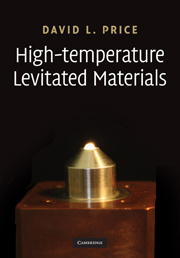2 - Levitation methods
Published online by Cambridge University Press: 23 April 2010
Summary
A variety of levitation techniques are available to the researcher to study high-temperature materials in the normal and supercooled states. The most widely practised techniques at the present time are aerodynamic levitation, in particular conical nozzle levitation (CNL), various kinds of magnetic levitation including electromagnetic levitation (EML), and electrostatic levitation (ESL). Other methods developed for specific applications such as acoustic levitation and gas-film levitation are less widely used and will be discussed only briefly.
In order for levitation to be useful in a scientific experiment, it is important not only to supply a force that can counteract the gravitational field but also to maintain the sample in a configuration that is sufficiently stable to allow the measurements to be performed. The issue of stability may be quite complex. A prime example is the Levitron®, a popular toy in which a spinning magnetic top is suspended above a flat surface of a magnetic material (http://www.levitron.com/). The levitating force is obvious, but the stability requires a complex physical analysis (Berry,1996; Berry & Geim, 1997).
The variety of methods in current use suggests that each one has particular advantages and disadvantages, depending on the application in hand. CNL is a relatively simple and versatile technique and can be readily incorporated into different kinds of experimental apparatus. EML is restricted to conducting samples, generally metals, in which case relatively large samples (up to 1–2 cm diameter if desired) can be levitated.
- Type
- Chapter
- Information
- High-Temperature Levitated Materials , pp. 3 - 22Publisher: Cambridge University PressPrint publication year: 2010

